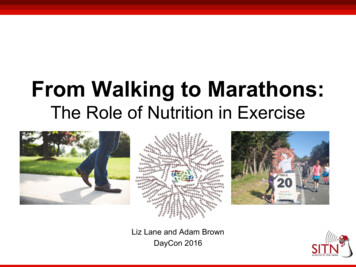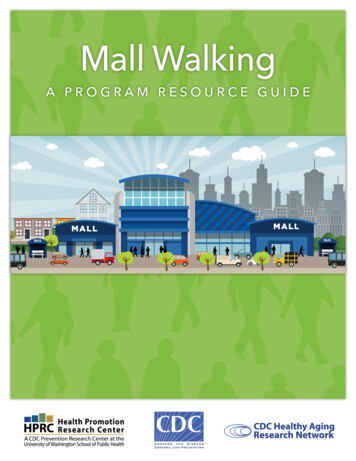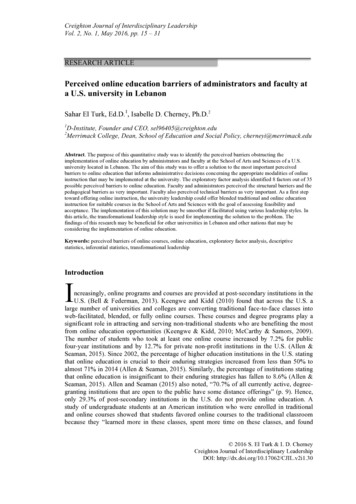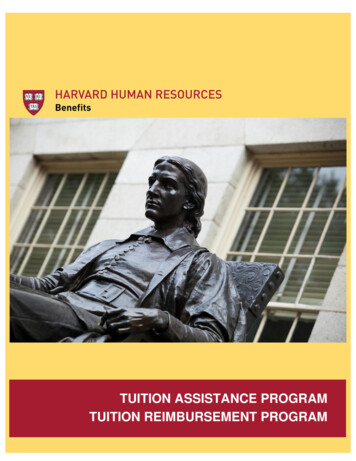
Transcription
From Walking to Marathons:The Role of Nutrition in ExerciseLiz Lane and Adam BrownDayCon 2016
RoadmapBackground: Metabolism and ExerciseVignettes Endurance Athletes and Carb Loading Diabetes and Walking
RoadmapBackground: Metabolism and ExerciseVignettes Endurance Athletes and Carb Loading Diabetes and Walking
Why do we need to eat?FoodUses for nutrients1. Broken down for energy2. Stored for later use3. Used as building blocks forbiomolecules (ex.building new muscle)
The body requires energy tofunctionBMR is dependent on 3variables Weight Height AgeFor a 25 year old man6 feet 175 poundsBMR 1,651 tml
The energy requirement of thebody increases with exerciseRomijin et al, 1993
Three types of nutrients in foodsHigh Protein FoodsAmino acidsHigh Carb FoodsHigh Fat FoodsSugarsFatty acids
Three types of nutrients in foodsHigh Protein FoodsAmino acidsGlucoseHigh Carb FoodsHigh Fat FoodsSugarsFatty acidsFructoseGalactoseMonosaccharides (one sugar)GlucoseFructoseDisaccharides (table sugar)Complex carbs (starch)
Three types of nutrients in foodsHigh Protein FoodsAmino acidsGlucoseHigh Carb FoodsHigh Fat FoodsSugarsFatty seDisaccharides (table sugar)Complex carbs (starch)Triglycerides
Three types of nutrients in foodsHigh Protein FoodsAmino acidsGlucoseHigh Carb FoodsHigh Fat FoodsSugarsFatty seDisaccharides (table sugar)Complex carbs (starch)Triglycerides
How do we get energy fromnutrients (the importance of oxygen)?Aerobic Metabolism: Requires OxygenAnaerobic Metabolism: No OxygenGlucoseTriglyceridesTriglyceridesOxygen2 ATP36 ATPATP Energy
Carbohydrates vs. fats as anenergy sourceATP Produced Per OxygenSpeed of useEnergy Produced per gATP The main energy source of the cellGlucoseFatty Acids 6 ATPs 4.5 ATPRapidSlow4 Cal of energy9 Cal of energy
Carbohydrates are the preferredenergy source during intense workouts% Max Intensity
Medium intensity workoutsburn the most fat
What happens when bloodglucose isn’t enough?Data from http://www.medbio.info/
After using up glucose, the bodyswitches to glycogenData from http://www.medbio.info/
What is Glycogen?Glycogen is thestorage form ofcarbs and made inliver and musclewhen bloodglucose is highGlucosemonomerslinkedtogetherProtein core:anchor forglucosechains
Glycogen is an excellent sourceof energy but stores are limitedData from http://www.medbio.info/
The body has large energyreserves in fatData from http://www.medbio.info/
During endurance exercise the bodybegins to use more fat for energyCarbs
Questions?
RoadmapBackground: Metabolism and ExerciseVignettes Endurance Athletes and Carb Loading Diabetes and Walking
“Hitting the wall”during prolonged exercise An athlete “hits the wall”when they use up all theirglycogen stores, causingblood glucose to drop To avoid ‘hitting the wall’– Maximize glycogen stores– Replenish carbohydratesduring exercise (using energygels, etc.)
Carb loading isn’t just eating pastathe night before a raceDiet and exercise 1 week before marathon10010075605040252000123456Percentage CarbExercise Time(min)80Muscle Glycogen Content
Does carb loading improveperformance for endurance exercise?8 endurancetrainedcyclistsHigh CarbDiet- withpotato starchsupplement3 days prior to testparticipants wereassigned to eitherPerformancetest:1. 2 hour ride at65% max workwith 60 secsprints at 6intervals2. Max intensityride for 1 hourMeasureglycogenNormal dietRepeat with participantsin other diet groupRauch et al, 1995
Carb loading for 3 days increasesmuscle glycogen contentRauch et al, 1995
Carb loading for 3 days increasesperformance in cycling testAverage power (W)Increased power output inperformance ride after carb loadingIncreased distance traveled inperformance ride after carb loadingNormal DietHigh Carb DietPerformance Ride (min)Distance 1 hr (Km)Normal DietHigh Carb DietRauch et al, 1995
Fact and fiction of carbohydrate loading Carb loading is a multi-day process The purpose of carb loading is to increaseglycogen stores A word of caution– Carb loading can cause gastrointestinal distress– Carb loading can increase the risk of diabetes
Questions?
RoadmapBackground: Metabolism and ExerciseVignettes Endurance Athletes and Carb Loading Diabetes and Walking
Glucose: a double-edged swordGlucose is necessary for your body duringrest and exercise alike, but diabetics havetoo much blood sugarToo much blood sugar can hurt manyorgans, including the heart, kidneys andeyes
Diabetes and Exercise Daily monitoring combined with physicalactivity improves long-term health1 Many diabetics aren’t mobile enough forstrenuous exercise, so walking is oftensuggested as an alternative[Left, Right] Images from Wikimedia Commons, under a CC license[1] American Diabetes Association (2002). Diabetes mellitus and exercise.
Walking as ExerciseWalking is often recommended by doctors toimprove diabetes and general health1[Left] Image from Pexel, under CC license, [Right] Image from FitZone, under CC license, [1] CDC Recommendations
What’s the right number ofsteps to take each day?“Use a pedometer to count how many stepsyou take each day. Each week aim toincrease your daily step count by 1,000 stepsuntil you reach 10,000 steps a day.”- American Heart Association Governments and Companies most oftensuggest 10,000 steps/day Numbers are the same for diabetics[Left] Image from FitBit blog ( FitBit, 2016) [Right] Image from 10,000 Steps Australia, ( Walk with Attitude, 2016)
Where does 10,000 steps perday come from? 10,000 steps a day (manpo-kei) was coinedby Y. Hatano in the mid 1960’s as a tool tosell pedometers1[Left] Image from Mi Community, under CC license, [Right] Image from Yamasa-Tokei, under CC license[1] Catrine Tudor-Locke (2003). Manpo-Kei: The Art and Science of Step Counting.
Two Open Questions1. Does walking directly impact blood glucosein diabetics? If so, at what time scales?2. Are population-level trends applicable toindividual diabetics? Will walking helpeveryone equally?
The GlucoSuccess iPhone App
Mean Blood GlucoseDoes Walking Lower BloodGlucose?Mean Step Count Probably. Among 2,496 diabetics, walking1K more steps per day was associated with1 point (mg/dL) lower fasting blood glucose(measured over 9 months)
Daily Blood GlucoseWhat about in the short-term?Daily Step Count We looked at day-to-day impact of walkingon glucose and found a significant, but smalland very noisy relationship
Lessons from GlucoSuccess1. Overall, blood glucose in diabetics isprobably tied to daily step count2. BUT, the relationship is complex and notgeneralizable from person to person3. 10K a day is nice, but we need morepersonalized recommendations
WalkingEndurance ExerciseHitting the WallLow GlucoseHigh GlucoseCarbo LoadingLifestyleDiseaseDiabetes
Questions?
Thank you!SITN would like to acknowledge the followingorganizations for their generous support.Harvard Medical SchoolOffice of Communications and External RelationsDivision of Medical SciencesThe Harvard Graduate School of Arts and Sciences (GSAS)The Harvard Graduate Student Council (GSC)The Harvard Biomedical Graduate Students Organization (BGSO)The Harvard/MIT COOP
Aerobic vs anaerobic metabolismPros of aerobicmetabolism1. Produces a lot ofenergy2. Long lastingCons of aerobicmetabolism1. Requires oxygen2. Slower thananaerobicmetabolism36ATPAerobic MetabolismRequires oxygenAerobic MetabolismRequires oxygenPros of anaerobicmetabolism1. Fast2. Does not requireoxygenFatty acidsCons of anaerobicmetabolism1. Inefficient2. Produces toxicby-product3. Lasts only acouple of minutes2 ATPATP: Main source ofenergy for the cell
Anaerobic metabolism is briefduring exercise
Is 10,000 steps per daysupported by science?“most of the benefit is achieved by 8000 steps per day”- Ewald et al., 2014 (J Phys Act Health)“The findings suggest that 10,000 to 11,000 and 7700 to 8000 steps/drepresent the optimal thresholds [depending on which activity goal youchoose]”- Cao et al., 2014 (J Phys Act Health) The verdict is still out, but the evidencesuggests that 10K/day isn’t a “magicnumber” of steps
Aerobic metabolism can useboth glucose and fatsPros of aerobicmetabolism1. Produces a lot ofenergy2. Long lastingCons of aerobicmetabolism1. Requires oxygen2. Slower thananaerobicmetabolism36ATPAerobic MetabolismRequires oxygenAerobic MetabolismRequires oxygenPros of anaerobicmetabolism1. Fast2. Does not requireoxygenFatty acids2 ATPATP: Main source ofenergy for the cellCons of anaerobicmetabolism1. Inefficient2. Produces toxicby-product3. Lasts only acouple of minutes
Aerobic metabolism can use both glucose and fats Fatty acids ATP: Main source of energy for the cell Pros of anaerobic metabolism 1. Fast 2. Does not require oxygen Cons of anaerobic metabolism 1. Inefficient 2. Produces toxic by-product 3. Lasts only a couple of minutes Pros of aerobic metabolism










